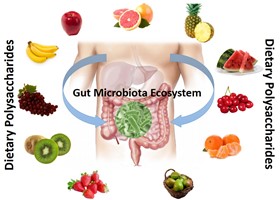- 5.0Impact Factor
- 9.1CiteScore
- 13 daysTime to First Decision
Dietary Polysaccharides and Gut Microbiota Ecosystem
This special issue belongs to the section “Carbohydrates“.
Special Issue Information
Dear Colleagues,
The community of microorganisms that subsists within the gastrointestinal (GI) ecosystem is called the intestinal microbiota. In human health, the role of the gastrointestinal microbiota is to maintain a dynamic balance with the host, playing both local and remote roles in important physiological processes, particularly inflammation, and the immune response.
Polysaccharides are the most abundant dietary components in the gut microbiota and are deeply involved in host health. Emerging evidence shows the involvement of polysaccharides in numerous functions in gut microbiota-host symbiosis, such as microbial interactions with endogenous host glycans, and the important role of microbial polysaccharides. Additionally, bacterial polysaccharides act as immunomodulators, and host-derived polysaccharides not only protect host cells from pathogenic microbial neighbours but also affect overall gut health through interactions with gut microbes. In the course of intestinal fermentation, polysaccharides (among others) can promote the growth of certain intestinal bacteria, thus changing the profile of the intestinal microbiota and affecting the physiology of the host both locally and remotely, which can contribute to the development of diseases.
We welcome different types of manuscript submissions, including original research articles and up-to-date reviews (systematic reviews and meta-analyses).
Potential topics may include but are not limited to the mechanisms of action involving changes in microbiota affected by polysaccharides or vice versa, associations between dietary polysaccharides and health. Mechanisms through which polysaccharides may affect host-microbe symbiosis in the gut, resulting in metabolic disorders. The exploration of polysaccharides as potential functional biomaterials for manipulating the gut microbiome.
Dr. Ana Isabel Alvarez-Mercado
Dr. Julio Plaza-Díaz
Guest Editors
Manuscript Submission Information
Manuscripts should be submitted online at www.mdpi.com by registering and logging in to this website. Once you are registered, click here to go to the submission form. Manuscripts can be submitted until the deadline. All submissions that pass pre-check are peer-reviewed. Accepted papers will be published continuously in the journal (as soon as accepted) and will be listed together on the special issue website. Research articles, review articles as well as short communications are invited. For planned papers, a title and short abstract (about 250 words) can be sent to the Editorial Office for assessment.
Submitted manuscripts should not have been published previously, nor be under consideration for publication elsewhere (except conference proceedings papers). All manuscripts are thoroughly refereed through a single-blind peer-review process. A guide for authors and other relevant information for submission of manuscripts is available on the Instructions for Authors page. Nutrients is an international peer-reviewed open access semimonthly journal published by MDPI.
Please visit the Instructions for Authors page before submitting a manuscript. The Article Processing Charge (APC) for publication in this open access journal is 2900 CHF (Swiss Francs). Submitted papers should be well formatted and use good English. Authors may use MDPI's English editing service prior to publication or during author revisions.
Keywords
- Polysaccharides
- Microbiota
- Microbiome
- Metabolic disorders
- Diet
- Health
- Microbiota-host symbiosis

Benefits of Publishing in a Special Issue
- Ease of navigation: Grouping papers by topic helps scholars navigate broad scope journals more efficiently.
- Greater discoverability: Special Issues support the reach and impact of scientific research. Articles in Special Issues are more discoverable and cited more frequently.
- Expansion of research network: Special Issues facilitate connections among authors, fostering scientific collaborations.
- External promotion: Articles in Special Issues are often promoted through the journal's social media, increasing their visibility.
- e-Book format: Special Issues with more than 10 articles can be published as dedicated e-books, ensuring wide and rapid dissemination.

